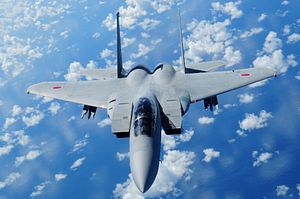The Japan Air Self Defense Force (JASDF) has doubled the number of fighter jets dispatched to intercept foreign military aircraft approaching Japanese airspace from two to four in 2016, sources within Japan’s Ministry of Defense revealed on February 25.
The increase in JASDF fighter jets responding to potential airspace violations comes amidst rising tensions with China over its growing military presence in the East China Sea, where Beijing and Tokyo both claim sovereignty over a group of uninhabited islands, known in Japan as the Senkakus and in China as the Diaoyus. It is also in the East China Sea where both countries’ air defense identification zones overlap.
“According to the sources, an increasing number of Chinese aircraft have been flying past 27 degrees north latitude, which Japan considers a defensive border line. Japan’s goal is to keep Chinese planes out of the area between 25 and 26 degrees latitude, which encompasses the Senkakus,” The Japan Times reported over the weekend. In order to do so, the JASDF has been stepping up its presence in the region over the last year.
As I reported previously, for the first time in about 50 years, the JASDF stood up a new air wing consisting of Mitsubishi F-15J all-weather air superiority fighters in Okinawa, Japan’s most southern prefecture in early 2016. The creation of the JASDF’s new 9th Air Wing doubled the number of fighter jets from 20 to 40.
As I explained in January 2016:
Japan’s MoD (…) announced earlier in the month that it recorded an uptick of 36 percent in the number of times the JASDF had to dispatch fighter jets in response to foreign military aircraft approaching the country’s airspace. Between April and December 2016, the JASDF scrambled its warplanes 883 times — 644 times in reaction to People’s Liberation Army Air Force aircraft and 231 times in reaction to the Russian Aerospace Forces. Six incidents involved Republic of China Air Force aircraft.
However, no Chinese or Russian warplanes entered entered Japan’s airspace in 2016.
While the JASDF relies on E-2C early warning airplanes and Boeing E-767 airborne warning and control system (AWACS) aircraft, the JASDF’s workhorse for intercepts remains the F-15J fighter jet, of which Japan currently operates around 215 (including the upgraded F-15DJ/F-15J Kai variants).
F-15J fighter jets are now operating in a new defense in depth formation. “Of the four F-15s scrambled each time, two in the rear will be on alert to deal with any additional aircraft that join the incursion,” according to The Japan Times.
The doubling of aircraft used for scrambles against foreign military aircraft will put additional pressure on an already overstretched JASDF. Unless Japan steps up its procurement process and accelerates the introduction of new aircraft (e.g. the F-35), the JASDF will likely face a shortage of fighter aircraft in the 2020s.































